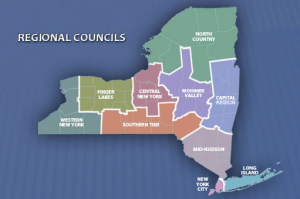The predicted irrelevance of cities, offered by some as a consequence of the Internet and the falling cost of communication, has been proven to be false. Scholars like Bruce Katz of the Brookings Institute have long recognized and championed the economic significance of regions.
New York State’s Governor Cuomo agrees—since taking office, he’s been working hard to shift the initiative for economic development away from central decision-makers in Albany and NYC to the regions. It is no accident that Bruce Katz has served as an informal Cuomo advisor, the two having worked together when Cuomo was HUD Secretary under Bill Clinton.
Here in the Finger Lakes, the Regional Economic Development Council (FLREDC) is charged with developing and implementing an economic development plan for the region. A coalition of business, non-profit and government representatives, the FLREDC has been empowered to chart out the region’s strengths and how best to support its growth into the future. At the state level, many grant programs have been brought together in support of the strategies identified locally and set out in the plan. The Governor has also focused the work of state agencies. Attending Monday’s FLREDC meeting were regional representatives from a number of NYS departments and agencies (e.g. State, Labor, Agriculture & Markets, and NYS Energy Research & Development Authority), all part of the State Agency Resource Team (SART). Additionally, the state has identified action that it can take to support implementation, including expediting regulatory review of priority projects. In essence, the state has asked the region to “tell us what you need” so that it can support local efforts for job creation and economic growth. While NYS retains significant discretion over uses of state funds, the Cuomo Administration is making a concerted effort to engage regional players in the decision process.
The Council has been a catalyst for a dialogue about the future of the region, a region that includes both the Rochester metro area and the rural counties of the Finger Lakes. The FLREDC is a big tent that brings people together who might not otherwise have had occasion to collaborate. It has given the region a voice to define the future from the ground-up rather than being given a plan from the top-down. And it harnesses and aligns state resources in support of the Finger Lakes vision.

Regions matter because they enable people and companies to cluster together, building on one another’s strengths. While there is an important economic development role for state and federal government, these higher levels must also align their own strategies and resources in support of locally-driven regional economic development.
Other countries are implementing changes in tandem with NYS in support of their own regional economies. For example, the British Government has recently announced plans to devolve new powers to England’s eight biggest city-regions outside of London. This is fairly significant shift whose aim is to empower local leaders to drive growth. According to a recent report, the Coalition Governments wants “powerful, innovative cities that are able to shape their economic destinies, boost entire regions and get the national economy growing”.
Each region has developed a different approach. For example, Greater Manchester’s Earn Back Model will raise £1.2B and invest it in growth maximizing projects. Like a “tax increment financing” model, Greater Manchester will “earn back” a portion of the national tax revenue that is raised from growth in gross value added (GVA) that occurs within the region. The revenue that is earned back will then be re-invested in new projects. Although it was never implemented, a Task Force on Community Opportunities in the Province of British Columbia made a similar recommendation in this report.
The FLREDC does not go as far as Manchester’s Earn Back Model, but it is aimed at improving state-local collaboration and in harnessing the potential of regions to chart their economic futures. Both are examples of higher levels of government asking their regions to “tell us what you need” in order to be economically competitive in today’s world.